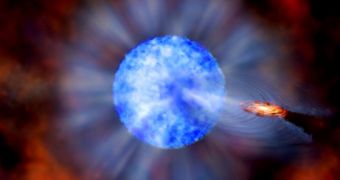This is the most massive stellar black hole ever found: a new odd one blocked in a tight orbit with a huge star, in a galaxy located in the proximity of the Milky Way. Stellar black holes emerge when a huge star's core dies, forming an area with such a powerful gravitational pull that even light can't escape. Supermassive black holes weighing millions of suns are suspected to exist at the centers of many galaxies, including Milky Way, our galaxy.
"The newly described stellar black hole has a mass almost 16 times that of our sun," said lead author Jerome A. Orosz, a professor of astronomy at San Diego State University.
"Before this, the most massive known stellar black hole was GRS 1915+105, with a black-hole mass estimated to be 14 plus or minus 4 solar masses. But the mass of GRS 1915+105 has recently come into question," he added.
The black hole's companion star is 70 times heavier than the Sun, representing the largest star in a binary system comprising a black hole.
"The present-day companion is no more than about three million years old. The model suggests that it will die in another two to three million years, forming another black hole." said Orosz.
The mass of the black hole in a binary system can be assessed by determining its gravitational tug on the star. This binary system, called M33 X-7, was first discovered in 1981 and it is located in Meisser 33, a spiral galaxy found three million light-years away. The companion star moves directly in front of the black hole on its three-day orbit, covering the black hole's x-ray emissions.
This pattern permitted the team to combine information from NASA's orbiting Chandra X-Ray Observatory and the Gemini North Telescope on Mauna Kea, Hawaii, to determine the masses of the two objects with extreme accuracy.
It's not clear how a massive black hole appeared in close orbit to a huge companion star, but this is suspected to comprise the remains of dead stars, like white dwarfs, neutron stars and black holes, in a stage called the common-envelope phase, when a dying star in a binary system loses its outer layers while attracting the other star closer, resulting a tight binary system.
"During the common-envelope phase, the progenitor of the M33 X-7 black hole must have lost a large amount of mass for the two objects to be so close," said Tomasz Bulik, of the University of Warsaw.
"In this system we know that quite a lot of mass was expelled, and on the other hand that the remaining mass formed the black hole. Thus we have an upper and lower bound on the amount of mass expelled." Bulik told National Geographic News.
"The reason M33 X-7 is so hard to understand is that both the black hole and the companion star have a very high mass.
The predicted mass loss [of the star as it died before becoming a black hole] is so great that M33 X-7 should not have been able to enter a common-envelope phase." said Orosz.
"The common-envelope stage is poorly known, and this system will help us understand it." said Bulik.
An independent team led by Andrea H. Prestwich of the Harvard-Smithsonian Center for Astrophysics could have found an even more massive stellar black hole, 24 to 33 heavier than the sun. This binary system is located at 2.2 million light-years away in the galaxy IC 10, but more data is required to clearly classify that object as a black hole.

 14 DAY TRIAL //
14 DAY TRIAL //